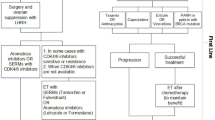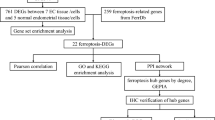Abstract
Estrogen plays an important role in the growth and progression of human breast cancer. Understanding the whole picture of estrogen signaling is a very important goal towards clarifying the biology of this disease. On the other hand, hormonal therapy for breast cancer has been progressing rapidly with the advent of drugs such as selective estrogen receptor (ER) modulators and aromatase inhibitors. Prediction of individual response to these hormonal therapies is becoming important for the management of breast cancer patients. To help address these basic and clinical issues, we are developing several new tools such as the focused microarray and the green fluorescent protein-reporter cell system. We first carried out expression profiling of approximately 10,000 genes in ER-positive breast cancer cells. Based on the results, estrogen-responsive genes (ERG) were selected and a custom-made cDNA microarray consisting of 200 genes from a narrowed-down subset was produced. Using this microarray, we investigated various aspects of estrogen signaling such as the effect of estrogen-antagonists on ERG expression profile and functional analysis of ERβ and novel estrogen responsive gene EGR3. Furthermore, expression levels of several candidate genes selected from the custom-array contents were analyzed by real-time RT-PCR and immunohistochemistry using breast cancer tissues to determine novel predictive factors for responsiveness to hormone therapy in primary breast cancer patients. Expression of several genes, such as HDAC6, significantly correlated with disease-free and overall survival of patients treated with adjuvant tamoxifen therapy. We are currently developing a new tool for analyzing the effects of novel aromatase inhibitors in individual breast cancer patients using estrogen-responsive element-green fluorescent protein-indicator cells. We hope that these approaches may provide not only new clues for elucidation of estrogen-dependent growth mechanisms of cancer, but also clinical benefits to patients by assessment of individual responses to endocrine therapy.



Similar content being viewed by others
References
Aoyagi K, Tatsuta T, Nishigaki M, Akimoto S, Tanabe C, Omoto Y, Hayashi S, Sakamoto H, Sakamoto M, Yoshida T, Terada M, Sasaki H (2003) A faithful method for PCR-mediated global mRNA amplification and its integration into microarray analysis on laser-captured cells. Biochem Biophys Res Commun 300:915–920
Gruvberger S, Ringnér M, Chen Y, Panavally S, Lao HS, Borg Å, Fernö M, Peterson C, Meltzer PS (2001) Estrogen receptor status in breast cancer is associated with remarkably distinct gene expression patterns. Cancer Res 61:5979–5984
Hayashi S, Imai K, Suga K, Kurihara T, Higashi Y, Nakachi K (1997) Two promoters in expression of estrogen receptor messenger RNA in human breast cancer. Carcinogenesis 18:459–464
Hayashi S, Hajiro-Nakanishi K, Makino Y, Eguchi H, Yodoi J, Tanaka H (1997) Functional modulation of estrogen receptor by redox state with reference to thioredoxin as a mediator. Nucleic Acids Res 25:4035–4045
Hayashi S, Sakamoto T, Inoue A, Yoshida N, Omoto Y, Yamaguchi Y (2003) Estrogen and growth factor signaling pathway: basic approaches for clinical application. J Steroid Biochem Mol Biol 86:433–442
Hayashi S (2004) Prediction of hormone sensitivity by DNA microarray. Biomed Pharmacother 58:1–9
Hayashi S, Eguchi H, Tanimoto K, Yoshida T, Omoto Y, Inoue A, Yosida N, Yamaguchi Y (2003) The expression and function of ERα and β in human breast cancer and its clinical application. Endocr Relat Cancer 10:193–202
Inoue A, Yoshida N, Omoto Y, Oguchi S, Yamori T, Kiyama R, Hayashi S (2002) Development of cDNA microarray for expression profiling of estrogen-responsive genes. J Mol Endocrinol 29:175–192
Inoue A, Omoto Y, Yamaguchi Y, Kiyama R, Hayashi S (2004) Transcription factor EGR3 is involved in the estrogen-signaling pathway in breast cancer cells. J Mol Endocrinol 32:649–661
Omoto Y, Eguchi H, Yamamoto-Yamaguchi Y, Hayashi S (2003) Estrogen receptor (ER) β1 and ERβcx/β2 inhibit ERα ·function differently in breast cancer cell line MCF7. Oncogene 22:5011–5020
Saji S, Okumura N, Eguchi H, Nakashima S, Suzuki A, Toi M, Nozawa Y, Saji S, Hayashi S (2001) MDM2 enhances the function of estrogen receptor α in human breast cancer cells. Biochem Biophys Res Commun 281:259–265
Saji S, Hayashi S, Yoshida N, Inoue A, Hirose M, Horiguchi S, Funada N, Toi M (2005) Therapeutic utility of histone deacetylase 6 regulation via estrogen signaling in human breast cancer MCF-7. Oncogene (in press)
Sørlie T, Perou CM, Tibshirani R, Aas T, Geisler S, Johnsen H, Hastie T, Eisen MB, van de Rijn M, Jeffrey SS, Thorsen T, Quist H, Matese JC, Brown PO, Botstein D, Lønning PE, Børresen-Dale A-L (2001) Gene expression patterns of breast carcinomas distinguish tumor subclasses with clinical implications. Proc Natl Acad Sci USA 98:10869–10874
Tanimoto K, Eguchi H, Yoshida T, Hajiro-Nakanishi K, Hayashi S (1999) Regulation of estrogen receptor α gene mediated by promoter B responsible for its enhanced expression in human breast cancer. Nucleic Acids Res 27:903–909
Terasaka S, Aita Y, Inoue A, Hayashi S, Nishigaki M, Aoyagi K, Sasaki H, Wada-Kiyama Y, Sakuma Y, Akaba S, Tanaka J, Sone H, Yonemoto J, Tanji M, Kiyama R (2004) Using a customized DNA microarray for expression profiling of the estrogen-responsive genes to evaluate estrogen activity among natural estrogens and industrial chemicals. Environ Health Perspect 112:773–781
van’t Veer LJ, Dai H, van de Vijver MJ, He YD, Hart AA, Mao M, Peterse HL, van der Kooy K, Marton MJ, Witteveen AT, Schreiber GJ, Kerkhoven RM, Roberts C, Linsley PS, Bernards R, Friend SH (2002) Gene expression profiling predicts clinical outcome of breast cancer. Nature 415:530–536
West M, Blanchette C, Dressman H, Huang E, Ishida S, Spang R, Zuzan H, Olson JA, Marks JR, Nevins JR (2001) Predicting the clinical status of human breast cancer by using gene expression profiles. Proc Natl Acad Sci USA 98:11462–11467
Yoshida N, Omoto Y, Inoue A, Eguchi H, Kobayashi Y, Kurosumi M, Suemasu K, Higashi Y, Okazaki T, Kiyama R, Nakachi K, Fujita T, Hayashi S (2004) Prediction of prognosis of estrogen receptor-positive breast cancer with combination of selected estrogen-regulated genes. Cancer Sci 95:496–502
Yoshida T, Eguchi H, Nakachi K, Tanimoto K, Higashi Y, Suemasu K, Iino Y, Morishita Y, Hayashi S (2000) Distinct mechanisms of loss of estrogen receptor α gene expression in human breast cancer: methylation of the gene and alteration of trans-acting factors. Carcinogenesis 21:2193–2201
Zhang Z, Yamashita H, Toyama T, Sugiura H, Omoto Y, Ando Y, Mita K, Hamaguchi M, Hayashi S, Iwase H (2004) HDAC6 expression is correlated with better prognosis in breast cancer. Clin Cancer Res 10:6962–6968
Author information
Authors and Affiliations
Corresponding author
Additional information
This work was presented at the 20th Bristol-Myers Squibb Nagoya International Cancer Treatment Symposium, “New Concepts of Treatment Strategies for Hormone-Related Cancer”, 11–12 March 2005, Nagoya, Japan.
Rights and permissions
About this article
Cite this article
Hayashi, Si., Yamaguchi, Y. Estrogen signaling and prediction of endocrine therapy. Cancer Chemother Pharmacol 56 (Suppl 1), 27–31 (2005). https://doi.org/10.1007/s00280-005-0096-2
Published:
Issue Date:
DOI: https://doi.org/10.1007/s00280-005-0096-2




